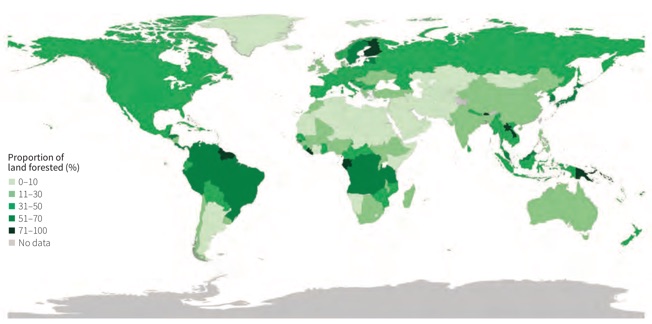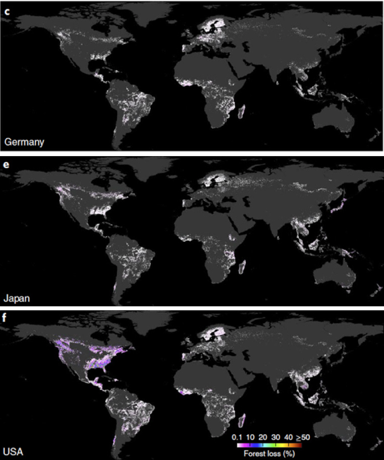News
17 March 2022
Deforestation, climate change and consumption
Forests play a central role in the evolution of the world climate. Their progressive depletion is a major cause - but also a consequence - of climate change. Human activities and the craving for consumption that often drives it, are key factors of deforestation. This article seeks to shed some light on this vital issue.
Forest land is decreasing at world level
According to FAO’s Global Forest Resources Assessment report of 2020 [read], the area covered by forests1 was 4.1 billion hectares (31.2% of the total land area) compared to 4.2 billion hectares in 1990. Over this period, it decreased by 4.2% or 178 million hectares.
Fig. 1: Forest area as a percentage of total land area, 2020

Source: FAO, 2020
In recent decades, the annual net decrease of area covered by forest slowed down (Table 1).
Table 1: Annual rate of forest land change per decade

Source: FAO, 2020
This evolution is the result of the combined effect of deforestation (human made, due to tree diseases and changes in climatic conditions), afforestation (planting or deliberate seeding of trees) and natural expansion.
Forest land fell in Sub-Saharan Africa, South-Eastern Asia and Latin America, mostly because of agricultural expansion [read]. In Africa, net loss of forest area actually accelerated since the 1990s, while it slowed down in Latin America. In contrast, net forest land increased between 2010 and 2020 in Asia, Oceania and Europe, mainly due to afforestation and natural expansion [read].
In absence of further analysis, these data could suggest that conditions are improving relatively (they deteriorate less now than in the past). But this impression hides a major threat.
First, tropical moist forests, which represent just over a quarter of world forest area, disappeared much faster than others, their surface decreasing by 17% (minus 220 million hectares) between 1990 and 2019. Second, 10% of these remaining tropical moist forests are degraded, degradation often being the precursory process of deforestation [read].
The case of the Amazon, in the following paragraph, shows that there is no good reason to be satisfied with a superficial reading of the global forest trends.
The Amazon time bomb
A recent study (Pronounced loss of Amazon rainforest resilience since the early 2000s) conducted by a team of German and British researchers provides evidence that three quarters of the Amazon rainforest have lost resilience2 since the early 2000s. This loss is faster in regions with less mean annual rainfall (because of climate change) and in parts of the rainforest closer to human activity. These research findings rest on a combination of simulations and direct observations of signs of falling resilience.
This process of loss of resilience is caused by climate change affecting forests, as it is difficult for trees to adapt rapidly to a longer dry season and more frequent droughts. This pushes forests close to a critical threshold of rainforest dieback that has profound consequences for biodiversity, carbon storage and climate change at a global scale [read].
It is worth remembering here that during the two major droughts of 2005 and 2010, the Amazon temporarily turned into a carbon emission source, due to increased tree mortality, instead of being as usual a massive carbon sink. This type of event could become more frequent in the future, with serious implications for the world climate.

Several studies suggest a vicious circle through which deforestation and forest degradation contribute to reduced moisture in their environment (because of less evapotranspiration by trees), which, in turn, impacts rainfall negatively and impinges on forest viability. With more droughts, local fires could evolve into megafires that would generate more greenhouse gas (GHG) emissions, while a diminished biomass and moisture due to fire would push temperatures upwards, with as consequence a potential disruption of the climate that would modify monsoon over the entire South American sub-region.
The researchers found that, as its condition becomes more unstable, the forest reacts more sluggishly to short-term perturbations. This means that even it there may be only limited signs of degradation of the forest now (measured by the level of presence of water and biomass), this could hide a major degradation of the forest in the future. Indeed, when it turns unable to respond to shocks (e.g. lower annual rainfall or more human activities), this may trigger a downward spiral as the vicious circle is put in motion on a larger scale. Such a process would then impact climate at global scale.
The authors conclude by saying that there is evidence for thinking that slowing down deforestation would not just protect the parts of the forest that are directly threatened, but also preserve the Amazon rainforest resilience over much larger spatial scales. Ultimately, it would help protect the global climate.
This conclusion is extremely worrying when remembering the policies implemented by the far-right government led by climate change negationist Jair Bolsonaro in support to loggers and agricultural companies wanting to develop soybean and livestock production in the Amazon [read].
There are good reasons to believe that what was observed in the Amazon region could also apply to other major tropical forests (e.g. in Central Africa and South-East Asia).
Consumers and causes of deforestation
There is abundant literature on the causes of deforestation. In the case of fast disappearing tropical forests, large-scale commercial agriculture (primarily cattle ranching and cultivation of soya bean and oil palm) is designated as the main culprit, being responsible for 40% of tropical deforestation between 2000 and 2010. Local subsistence farming comes generally second as it accounts for another 33% [read].
Conditions vary in different continents: in Latin America large-scale commercial agriculture is thought to be responsible for two thirds of deforestation, while in Africa and tropical parts of Asia, the top cause is expansion of subsistence farming [read].
Forestry practices are also part of the problem [read]. As we saw earlier in this article, climate change plays a crucial role in the process by reducing forest resilience. Other forms of human presence (mining, infrastructure works such as hydroelectric dams or roads, urbanization, introduction of invasive species and excessive logging) have a significant impact as well.
An interesting study trace back agricultural pressure on forest to consumption by providing “a fine-scale representation of spatial patterns of deforestation associated with international trade” [read].
With a 30 m resolution, researchers tracked deforestation over the period 2001-2015 and linked them to exports. Thus, they present evidence that rich countries, but also China and India, who succeeded in increasing their forest cover, actually create deforestation elsewhere, particularly in tropical countries from which they import goods (a similar process is taking place for GHG emissions [read]).
In the case of G7 members3, the study estimates that deforestation caused by imports is equivalent to 3.9 trees per person and per year (Fig. 2). In fact, it found that the UK, Germany, France, Italy and Japan imported in this way more than 90% of their deforestation footprints over the period analysed, of which between 46% and 57% impacting tropical forests.
Fig. 2: Number of annual embodied tree loss per person
(domestic, non domestic) (average over 2001-2015)

Source: Hoang & Kanemoto, 2021
Fig.3 shows the spatial distribution of deforestation footprints of three rich countries, illustrating their worldwide nature.
Fig. 3: Deforestation footprints of Germany, Japan and the US
(2001-2015)

Source: Hoang & Kanemoto, 2021
Fig. 4 reviews “deforestation trade” in 8 countries. The contrast is sharp between rich countries whose trade generates deforestation abroad, and those like Indonesia and Brazil where it is largely a consequence of their exports. It is worth noting that tropical forests are prominently concerned by this movement.
Fig. 4: Deforestation imports and exports from six forest “biomes”
in selected countries for in 2015

Source: based on Hoang & Kanemoto, 2021
download graph: balance.png
Conclusion
Forests are receding at world level. This is particularly true for tropical forests that are especially important for climate regulation and rich in biodiversity.
Evidence gathered from the Amazonian forest suggests that climate change and human activities are major causes of deforestation. In fact, there is some kind of a snowball effect involving climate change and deforestation: climate change is a factor of deforestation, and deforestation, when it occurs, tends to amplify climate change, as it generates more GHG emissions.
It is also established that observing the trend in deforestation is not sufficient for assessing what is going on in tropical forests. It is equally important, if not more, to monitor forest resilience, as when resilience decreases, it usually is a sign that forests are at risk. From this point of view, the Amazon forest (as well as probably those in Central Africa and in South-East Asia) is a climatic time bomb, if nothing is done to protect it from human activities.
Consumers have a major responsibility and role to play in the combat against deforestation and climate change, as the products they purchase have a (direct or indirect) impact on forests and their preservation. This is particularly true for consumers in rich countries, whose craving for tropical goods is a cause of deforestation in tropical areas.
Forests need to be protected, as the cost for humanity of not preserving them would be exorbitant. The burden of their protection should, however, be borne by all according to their means, including consumers who should decide on their consumption on the basis of its impact (social, economic and environmental). Those peoples who have been relying on forests for their livelihood should not take on more than their share of this burden, and they should have proper opportunities for improving their living standard and well-being.
----------------------
Notes:
-
1.Forest land is defined by FAO as “Land spanning more than 0.5 hectares with trees higher than 5 metres and a canopy cover of more than 10%, or trees able to reach these thresholds in situ. It does not include land that is predominantly under agricultural or urban land use.” This also includes “areas with young trees that have not yet reached but which are expected to reach a canopy cover of 10% and tree height of 5 metres” and “areas that are temporarily unstocked due to clear-cutting as part of a forest management practice or natural disasters, and which are expected to be regenerated within 5 years”. (FAO)
-
2.Resilience: ability to return to its original state after having been disturbed by an external factor.
-
3.Canada, Germany, France, Italy, Japan, United Kingdom and United States.
—————————————
To know more :
-
•Boulton, C.A., Lenton, T.M. & Boers, N., Pronounced loss of Amazon rainforest resilience since the early 2000s, Nature Climate Change 12, 271–278 2022.
-
•Hoang, N.T., Kanemoto, K. Mapping the deforestation footprint of nations reveals growing threat to tropical forests. Nat Ecol Evol 5, 845–853 2021.
-
•FAO, Global Forest Resources Assessment 2020: Main report. Rome, 2020.
Selection of past articles on hungerexplained.org related to the topic:
Last update: March 2022
For your comments and reactions: hungerexpl@gmail.com


